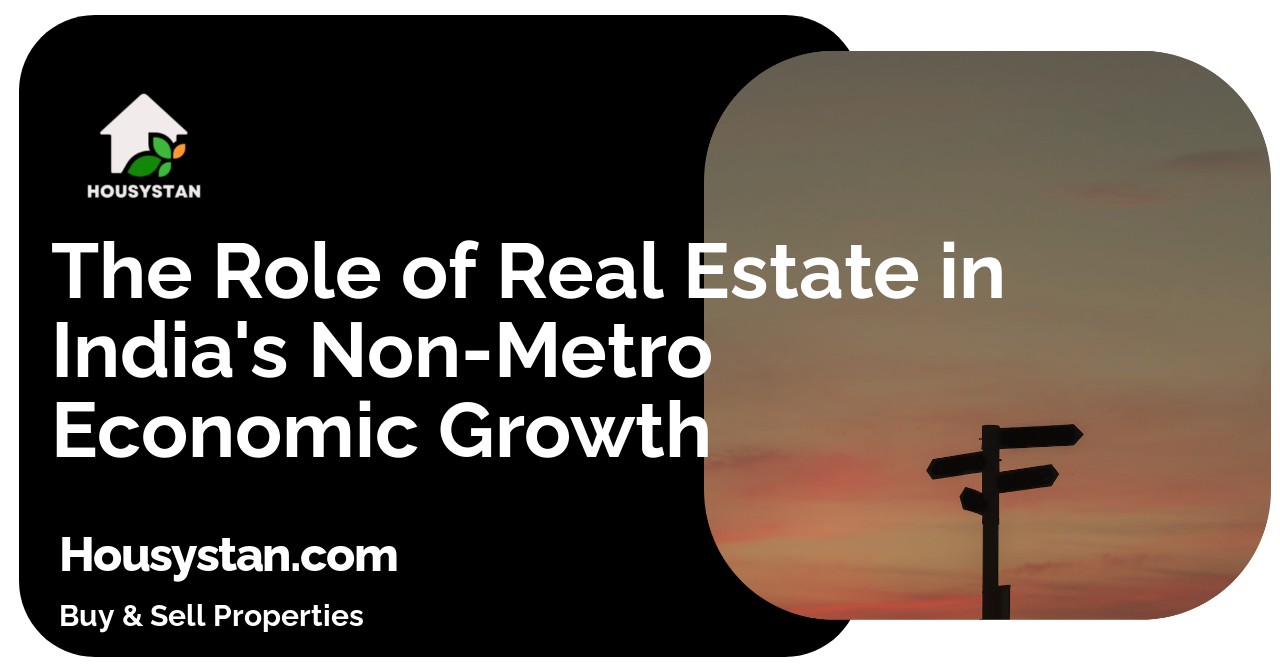The Role of Real Estate in India's Non-Metro Economic Growth
Read latest blogs and articles from Housystan

The Information mentioned here was last updated on:
2/12/2025Real Estate's Influence on Non-Metro Economic Growth in India
As India's bustling metropolitan cities continue to grow, there's also a significant transformation taking place in non-metro areas, often referred to as Tier 2 and Tier 3 cities. These smaller cities are witnessing substantial economic growth, and one of the key drivers of this transformation is the real estate sector. This blog post explores how real estate is contributing to the economic upliftment of non-metro areas in India.
Understanding the Non-Metro Economic Landscape
- Verified Tenants/Buyers
- Unlimited Property Listing
- Zero subscription/charges fee
Non-metro cities in India are those that fall outside the boundaries of the major metros like Mumbai, Delhi, Bangalore, and Chennai. They typically include cities like Jaipur, Ahmedabad, Coimbatore, and Indore, among others. In recent years, these cities have become hotbeds for growth, spurred by various factors including government policies, infrastructure development, and a burgeoning middle class eager for improved living standards.
The Real Estate Boom in Non-Metro Cities
Increased interest in real estate in non-metro cities is part of this growth story. There's a growing demand for both residential and commercial properties, fueled by an increasing population that desires modern amenities and better living conditions. Let's delve into the factors contributing to the real estate boom in these areas.
Affordable Housing and Increased Demand
One of the primary drivers of real estate development in non-metro cities is the demand for affordable housing. Rising property prices in metro cities have made home ownership an elusive dream for many. In contrast, non-metro areas offer more affordable options, attracting a large workforce migrating from rural areas or choosing to settle away from the high costs of metros. The availability of land at lower prices has encouraged developers to cater to this demand, thus fueling economic activity.
Government Initiatives and Policy Support
The Indian government has introduced several policies to boost the real estate sector, particularly in non-metro cities. Schemes such as the Pradhan Mantri Awas Yojana, which aims to provide affordable housing for all, have been instrumental in spurring real estate growth. Additionally, relaxed regulations and improved ease of doing business in these areas have made them attractive for developers. These policy measures not only promote real estate development but also create jobs and spur economic growth.
Infrastructure Development: A Catalyst
Improved infrastructure is pivotal in making non-metro cities attractive destinations for business and living. The government's focus on developing highways, better connectivity through air and rail, and other infrastructure projects have improved access to these cities. With infrastructure development, there is also a marked improvement in amenities such as schools, healthcare facilities, and entertainment, making these areas desirable for residents and businesses alike.
Rise of Commercial and Retail Spaces
Alongside residential development, there's significant growth in commercial and retail real estate. As businesses target these cities to tap into fresh markets, there's a need for office spaces, retail outlets, and shopping malls. This trend is attracting retailers and corporate entities to establish a presence in these emerging markets, thus fostering job creation and boosting local economies.
The Role of Technology in Real Estate Growth
Technology is playing a transformative role in non-metro real estate development. With the advent of digital platforms, property searches and transactions have become more accessible, offering buyers and sellers a wide range of choices and transparency. Additionally, smart city initiatives and the integration of technology in building management solutions are raising the standard of living and adding to the appeal of these real estate developments.
Population Growth and Urbanization Trends
Non-metro cities are seeing a significant influx of population due to urbanization trends. As people move for better opportunities and living conditions, the demand for housing and commercial spaces increases. This migration not only drives real estate demand but also stimulates local economies through increased consumption and investment.
Education and Workforce Development
The growth of educational institutions in non-metro areas is another driving force. With more colleges and universities setting up campuses, there's an increase in student populations, leading to higher demand for rental properties. Furthermore, educated graduates often choose to remain in these cities, contributing to the local talent pool and encouraging businesses to set up operations.
Challenges and Opportunities for Developers
While the potential for real estate growth in non-metro cities is immense, developers face challenges such as legal hurdles, land acquisition issues, and infrastructure bottlenecks. However, these challenges also present opportunities. Developers who can navigate these obstacles and leverage government incentives stand to gain significantly. Moreover, adopting sustainable building practices and community-centric developments can create long-term value.
Environmental Considerations and Sustainable Development
As real estate expands, considerations for sustainable development become crucial. Green building practices are gaining traction, with developers increasingly focusing on eco-friendly designs to meet the rising consumer awareness of environmental impacts. Sustainable practices not only reduce resource consumption but also enhance the quality of life, making non-metro cities more attractive for future generations.
Conclusion: A Continuous Growth Story
The role of real estate in India's non-metro economic growth is a testament to the country's evolving landscape. As these cities continue to develop and adapt, real estate remains a cornerstone of economic progress, fostering communities, creating jobs, and enhancing living standards. The promise of non-metro growth extends not just to residents, but also to investors, developers, and policymakers seeking sustainable urbanization paths in one of the world's fastest-growing economies.